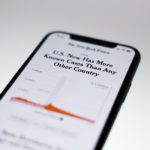 It’s fairly well established that media coverage of topics such as climate change is highly polarized, often along political and ideological lines. New research from the University of Michigan explores whether coverage of COVID-19 is similarly polarized.
It’s fairly well established that media coverage of topics such as climate change is highly polarized, often along political and ideological lines. New research from the University of Michigan explores whether coverage of COVID-19 is similarly polarized.
The analysis finds that both network news and newspaper coverage of the pandemic were highly polarized in the early weeks, which the researchers believe played a big role in shaping attitudes towards the pandemic among the public.
The researchers utilized various content analysis approaches and found that politicians were more frequently covered in the COVID newspaper coverage than scientists were, with a more equitable distribution in television coverage. The divide in opinion appeared almost immediately, however, which marks the topic out from climate change, for which divergence emerged over a longer timeframe.
“Polarization around COVID-19 is at least as high as coverage of climate change, if not higher. This is particularly striking as climate change is currently one of the most polarizing issues in the U.S. today,” the researchers say.
Polarized debate
The researchers define politicization as the degree to which politicians are mentioned in relation to an issue, whereas polarization is in relation to how the discussion changes depending on the presence of people from different political parties.
In total, the researchers assessed over 36,000 stories from USA Today, the Washington Post, the Philadelphia Inquirer, the New York Times, the Los Angeles Times, the Minneapolis Star-Tribune and the Atlanta Journal Constitution, and covered by ABC, CBS and NBC.
The assessment found that the politicization of newspaper coverage increased rapidly after the national health emergency was declared in March, and then remained at this elevated level throughout. The analysis also found that while political mentions rapidly overtook those of scientists, the scientific community nonetheless retained a consistently high level of coverage throughout.
The television coverage, however, was different, as politicization was much lower, despite polarization being very high. The levels of polarization were broadly consistent across both media and even across news sources, with polarized language used even when politicians weren’t the ones using it.
The researchers caution that such polarized and politicized news coverage is likely to significantly amplify any partisan differences in perceptions that have appeared during the pandemic. With research showing that adherence to social distancing and mask wearing have diverged along partisan lines, it’s a divide that the world can ill afford.